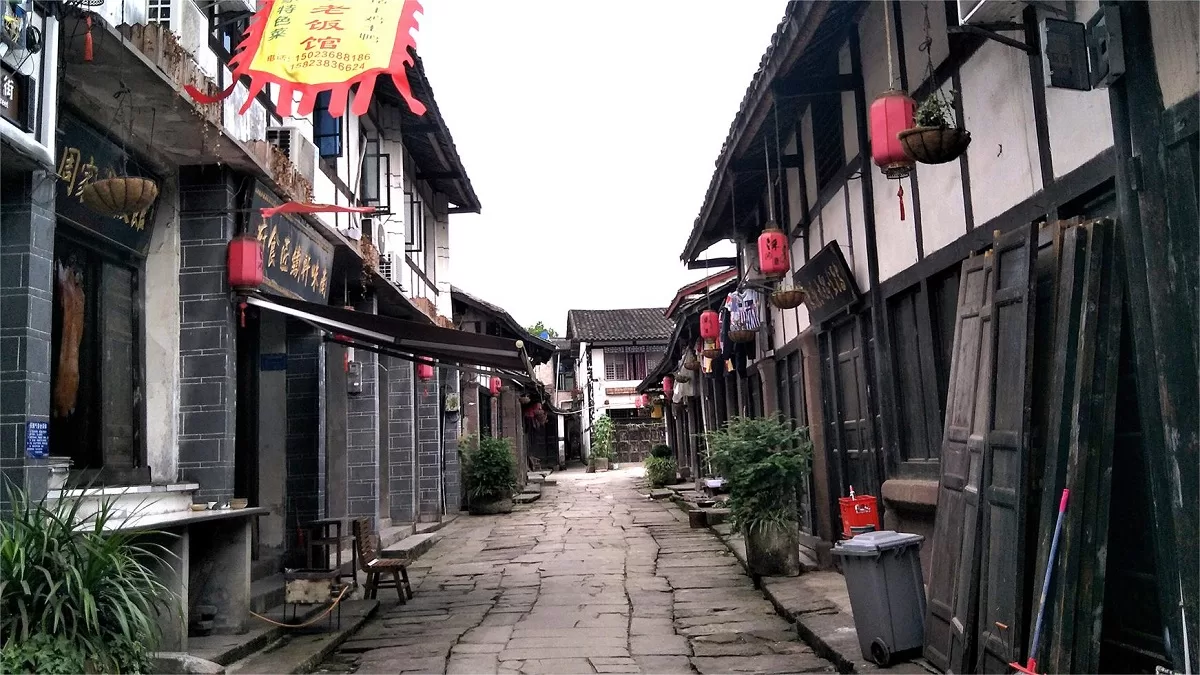Laitan Ancient Town (涞滩古镇), situated in the heart of Hechuan, Chongqing, is a historical treasure that dates back to the late Tang Dynasty and reached its zenith during the Song Dynasty. It was once a bustling hub for merchants and traders due to its strategic location along the Qu River and derives its name from this section of the river, known as Laitan. The town is divided into two parts, with the upper part nestled within a protective wall and the lower part overlooking the river.
Inside the town, more than four hundred well-preserved Qing Dynasty-era traditional dwellings await exploration. In recognition of its historical significance, Laitan Ancient Town was declared a key cultural heritage site of Sichuan Province as early as 1956, owing to its collection of late Tang Dynasty stone carvings, well-preserved Song Dynasty architecture, and numerous other historically and culturally significant landmarks.
Table of Contents
- Basic Information
- Location and Transportation
- Map of Laitan Ancient Town
- Highlights of Laitan Ancient Town
- Vlog about Laitan Ancient Town
- Useful Tips Summarized from Reviews
- Other Ancient Towns in Chongqing
Basic Information
| Estimated Length of Tour | 3 hours |
| Ticekt Price | Free |
| Opening Hours | 24 hours throughout the year |
| Telephone Number | 0086-023-42561888 0086-023-42561777 |
Location and Transportation
Laitan Ancient Town is situated in the northeastern part of Hechuan District (合川区), Chongqing, on the western bank of the Qu River, near . It is approximately 32 kilometers away from the central area of Hechuan District. Here’s how you can get to Laitan Ancient Town from Chongqing:
- From Chongqing Caiyuanba Bus Station:
- Chongqing Caiyuanba Bus Station offers daily bus services to Hechuan. You can take a bus directly to Hechuan from this station.
- Alternatively, you can take Bus 508 from Chongqing Railway Station to Hechuan.
- From Hechuan Bus Station:
- Upon reaching Hechuan, you can take a bus heading to Longshi (龙市), which should cost around 10 RMB.
- Get off at the Laitan Fen Intersection (Laitan Fen Lu Kou) in Hechuan.
- From there, you can either hire a motorcycle or take a small minivan to reach Laitan Ancient Town.
Map of Laitan Ancient Town

Highlights of Laitan Ancient Town
Ancient City Wall

The town’s ancient city wall, which was constructed during the Xianfeng period of the Qing Dynasty (1851-1861), underwent substantial renovations and reinforcements during the Tongzhi era (1862-1874). This effort resulted in a sturdy and well-preserved stone fortress that still encircles the town to this day. The town covers an area of 0.25 square kilometers and boasts a unique layout with four symmetrically positioned gates. The entire city wall is constructed from stone, giving it an impressive level of resilience.
Historical Architecture

Laitan Ancient Town is renowned for its picturesque landscapes, rich history, and a diverse blend of cultural influences, particularly the vivid customs of the Ba and Yu regions. It has retained the traditional layout and historical charm developed during the Qing Dynasty. As you stroll through the town, you’ll come across charming old streets, Ming Dynasty stone archways, and a cluster of Qing Dynasty pagodas, among other cultural gems. Notably, the well-preserved Qing Dynasty architectural marvel, Wenchang Sheng Palace, and the ancient opera house, adorned with woodcarvings and other historical artifacts, evoke a sense of wonder and admiration. The presence of Ming Dynasty stone archways, Qing Dynasty pagoda forests, Ming-Qing burial grounds, and various inscribed stone relics further enhance the town’s allure.
Shuanglong Lake

Located just 26 kilometers from Hechuan, Shuanglong Lake is a stunning man-made reservoir that was completed in 1983 and transformed into a thriving tourist destination in 1984. The lake covers a vast area with sparkling blue waters, spanning 6879 acres and featuring a shoreline extending over 80 kilometers. Shuanglong Lake boasts four full islands, 147 peninsulas, over 100 bays, and a maximum depth of 38 meters. It is a year-round water source, holding 40 million cubic meters of water. The lake’s pristine air and tranquil surroundings make it a haven for visitors seeking sightseeing, leisure, escape from the summer heat, conferences, and recreational activities.
Erfo Temple

Erfo Temple, nestled amidst Laitan’s enchanting scenery, is renowned for its collection of Zen Buddhist rock-carved statues. The temple houses 42 well-preserved niches, each adorned with over 1700 statues. The most prominent among them is a 12.5-meter-tall statue of Shakyamuni Buddha, also known as Erfo. The temple’s serene ambiance and intricate stone carvings offer a unique spiritual experience and a glimpse into ancient religious artistry.
Vlog about Laitan Ancient Town
Useful Tips Summarized from Reviews
Local Handicrafts: Laitan Ancient Town is known for its bamboo crafts, including items like bamboo sieves, rattan chairs, and bamboo baskets. These are all handmade by local artisans and are of good quality. Consider purchasing some as souvenirs, as they are both affordable and authentic.
Specialty Snack – Hechuan Peach Slices: Hechuan Peach Slices are a local specialty of Laitan. They come in two main flavors: sweet and soft, or savory and hard with a peppery salt flavor.
Authentic Atmosphere: Laitan Ancient Town retains a very primitive and authentic atmosphere. You’ll find small restaurants with rows of cured meat hanging outside, adding to the rustic charm. With fewer tourists, residents leisurely run their shops and enjoy chatting or playing mahjong during their free time.
Accommodation and Transportation: Since there are only small inns in the town itself, it’s recommended to stay in Hechuan city area. From there, you can take a bus from Hechuan Passenger Transport Station to Laitan Ancient Town in the morning and return in the afternoon. This allows you to experience the ancient town during the day while having the convenience of accommodation options and amenities in Hechuan city.








It’s worth visiting Laitan Ancient Town (涞滩古镇) again. The town is not big, with its old houses lining the bluestone alleys remaining unaltered, which is the true essence of an ancient town. My first visit was in 2008 when our enthusiastic host from Wusheng was a bit too generous with the drinks, so we ended up taking fewer photos. Sixteen years later, Laitan is still the same old Laitan. Over the years, I have revisited many ancient towns, seeing many… Read more »